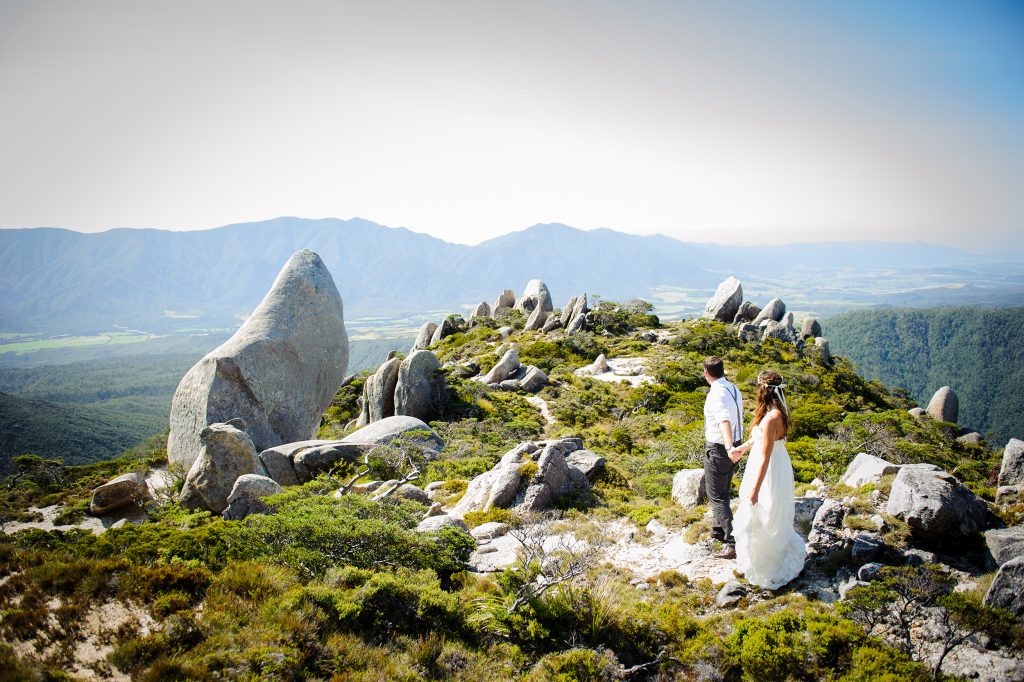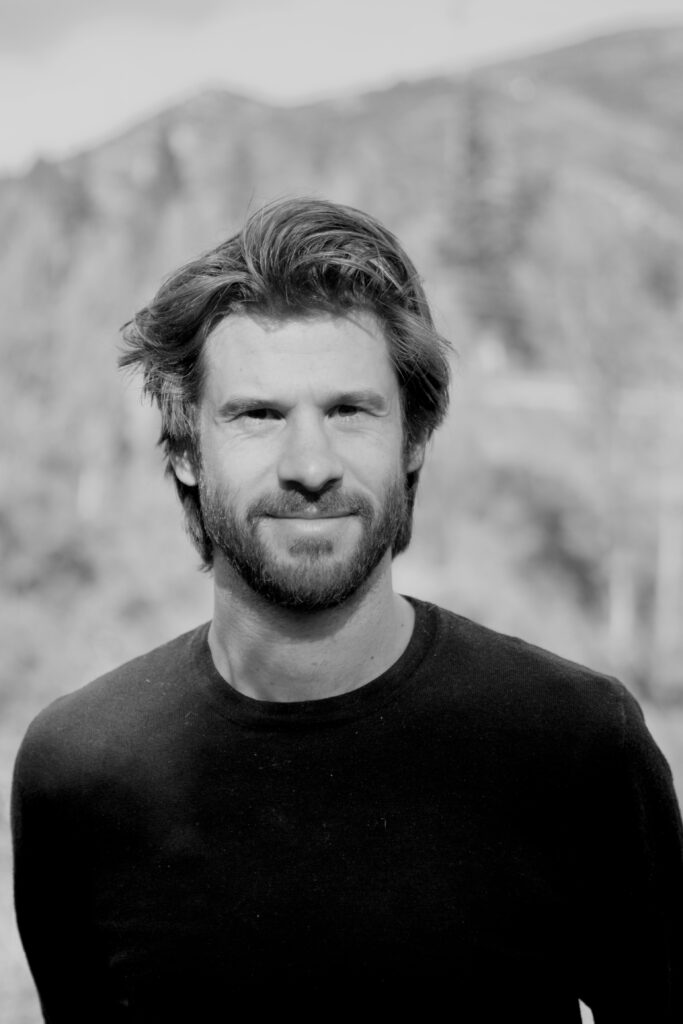From meeting your soul mate to rekindling a relationship, the backcountry is the perfect love potion. George Driver speaks to couples who found love in the hills
Walking side by side at an incredible location, gazing into a campfire under the stars – it’s probably not surprising that many relationships originate in the backcountry.
For Wynne Morgan and Sarah Child, a chance encounter in the Orongorongo Valley changed the course of their lives forever. Morgan was a caretaker at a private hut; Child was staying at a hut across the valley. They met atop the only hill in the valley with cell phone reception and hit it off immediately.
“When you meet someone, you just know,” Morgan says. “It was like that with Sarah – I knew it was going to go somewhere straight away.”
The couple started talking about their long association with the Orongorongo Valley – a shared experience that cemented their relationship.
“We just started talking and joking around,” Child says. “I was surprised how we’d both been visiting the valley for most of our lives, but we’d never met before.”
They had their first date that night – Morgan asked Child and her tramping party over to the hut for dinner and he cooked a backcountry stir-fry.
“I wasn’t taken by his cooking skills – but watching him have a go was quite amusing,” Child says. “The wok has never been out since.”
When they emerged from the bush, they met up for coffee. That was 12 years ago.
“Within a few weeks we were going back in the Orongorongo’s together and we’ve been together ever since,” Morgan says. “It was great to meet her in that environment – she likes all the things I like and we met in a place that is very special to us both.”
Morgan says the experience is a reminder Cupid can still strike in the backcountry.
“I never thought it would happen to me out there in such a remote place – I consider myself the luckiest man alive. But just because it’s remote and you’re on your own doesn’t mean you’re not going to meet your partner,” Morgan says.
Child agrees. “I tell everyone who’s single that if you want to meet the man of your dreams, head to a bush hut. It’s the perfect place because you’ve already got people who are like-minded and into the same experiences.”
Beyond serendipitous encounters, tramping clubs have long been known as an informal blind dating service. Otago Tramping and Mountaineering Club president Richard Forbes says the club has been known as the Tramping and Matrimonial Club, due to the number of marriages which have sprung from its ranks.
“You find the best and worst in a person on a tramping trip, so it’s the perfect testing ground for a relationship,” Forbes says. “You see a person when they are tired and hungry after a long day and getting a little snippy, but you also see them at their best.”

Federated Mountain Clubs president Peter Wilson says most of his friends met their partners in the backcountry. When asked for examples, he said: “anyone ex-OUTC” [Otago University Tramping Club].
OUTC president Lottie Armstrong says nothing has changed.
“It’s definitely still a place where couples meet,” she says.
She recalls one club member created a diagram, linking together dozens of other members through former and current relationships.
Christchurch counsellor Sarah Hardie’s is the second generation of tramping club hook-ups. She met her husband through the Christchurch Tramping Club 20 years ago. Her parents also met at the Canterbury University Tramping Club – a relationship that lasted 64 years.
Hardie had been a tramping club member for about six months before meeting her future husband.
“I was really interested in tramping and skiing and I kept hearing about this guy who was into the same thing. He kept hearing about me for the same reasons, but we were never on the same trips,” Hardie says.
The couple finally met at a Culverden fish and chip shop on the way to a club tramping trip to Lewis Pass.
“My husband always wants to head back to that fish and chip shop for our wedding anniversary, but I’m never keen on it,” Hardie says.
They hit it off immediately. On that first trip, someone asked them how long they had been together – the only problem was they both had partners at the time. But after tramping together over the next six months, they decided to start a life together.
Hardie’s parents met while signing up for clubs at the University of Canterbury noticeboard.
“My mother was signing up for the hockey club and my father was beside her and talked her into signing up for the tramping club too. Tramping was a huge part of their relationship and my sister and I were brought up tramping.”
Hardie says tramping clubs are a great way to meet a potential partner.
“You meet people in stressful situations, so you get to see how they manage when things aren’t going well and when they’re out of their comfort zone.”
She says it’s also a good way to meet a range of new people with similar interests.
“If you don’t hit it off with someone, there’s always someone else to meet and chat with. And there are always things to talk about – what’s around the next corner, how long to the hut, what’s for dinner – so there aren’t any awkward silences and there’s not the pressure of going on a date.”

According to relationship counsellor Janine Reichert there are good reasons why tramping often sparks romance. Heading on a tramping trip releases the same hormones as a budding romance, she says.
“When you are first in a relationship you get what we call the honeymoon high, which is a chemical reaction that our brains produce,” Reichert says. “You get a rush of dopamine, which makes you feel good and wanting more and a hit of adrenalin, which gives the feeling of excitement.
“But the brain also produces dopamine when you are having a new experience, like going on a hike, and the sense of danger of a trip into the outdoors can also produce adrenalin.
“So romance and tramping are basically stimulating the brain in the same way.”
It’s a fact that makes sense to Hardie.
“Tramping is exciting and it’s new, which is what romance is all about,” she says.
Reichert says a tramping trip can also be the perfect way to work through issues in a relationship. In her practice, Reichert uses ‘eco-therapy’, holding counselling sessions in the outdoors. She says taking people out of their normal environment allows them to focus on each other, away from the distractions and routines of everyday life.
“In the outdoors, people are able to leave behind issues that are holding them back from truly engaging.”
Being in the outdoors also reduces stress hormones, which can allow couples to work through issues in a less tense environment.
“If a couple is experiencing tension together, going into a natural environment has been shown to automatically reduce the release of stress hormones, which means you feel more connected to someone and more likely to be able to work through a problem,” Reichert says.
But she gives one caveat: make sure you both like being in the outdoors.
“If your partner doesn’t like camping or tramping, you can compromise and go for a short hike and stay in a bed and breakfast. It’s important to show you understand each other’s needs.”
A tramping trip also gives people time to talk and can be far better than a date night for rekindling a sense of romance.
“The problem with date nights is they are boring. You go to dinner and end up talking about the kids. It’s not something to look forward to. You’re much better to try new things and have new experiences.
“The outdoors can also be an incredibly romantic setting, gazing into a fire under the stars, or watching a sunset from a mountaintop.”
For people looking for a partner, a tramping trip also allows time to get to know each other without the pressure to fill in every silence.
“It’s really good for people who are anxious about dating.”

Rhonda Pritchard has been a relationship counsellor for 30 years and has written a book on the topic, Love in the Real World. She says heading on a tramping trip is a way to restore goodwill in a relationship.
“Being outdoors, doing exercise and being together is good for you in general,” Pritchard says. “But if there’s been some damage, stress or ongoing conflict in a relationship and both partners want to restore goodwill, being together in the outdoors can be a good way to make progress. Focusing on the outside world together and having an adventure could be one of the things that could restore some of that goodwill.”
Pritchard says often there is not enough play in a relationship – a tramping trip could be a good way to lighten things up.
“Just waking side by side, rather than sitting face to face, is a way in which couples feel more bonded – you’re facing out into the world together. It’s not a demanding or confrontational setting. Walking together, making comments about your surroundings and just being quiet together can be very therapeutic.”
The wilderness isn’t just a place to meet the love of your life, it can also be a place to marry them.
Terri Everett has a concession to officiate weddings in national parks in the Nelson area and says the New Zealand wilderness is attracting couples from around the world.
She holds about 20 weddings a year and about 80 per cent of the couples are from overseas – the highest proportion coming from Germany.
So why do people come around the world to tie the knot in the bush?
“People use it as an opportunity to combine a trip away with their wedding,” Everett says. “For what you can spend on a wedding, it doesn’t leave much for a honeymoon, so a lot of people are now combining the two. And who doesn’t want to get married in an incredible location?”
The rules around weddings in New Zealand are also very relaxed compared with other countries, she says.
“I can marry anyone, anywhere, whereas in the UK you have to be married at a registered location, which is often either a council office or a church.”
When Cantabrians Evan and Sarah Maguire wanted to get married somewhere close to their hearts – the ancient beech forest in Canaan Downs Scenic Reserve, near Abel Tasman National Park seemed perfect. The couple had been heading into the wilderness near Nelson for years and thought it would be ideal for a wedding.
“We didn’t want to get married in a place that had no meaning and Canaan Downs is a place that’s really special to us,” Maguire says. “Having a really natural wedding was important and Canaan Downs is where we often go for walks – it’s so beautiful.”
The couple were married under the forest canopy along with 50 guests, with an aisle running through the undergrowth.
“I would definitely recommend it. It was really memorable. It encouraged our friends and family to go to a place they might not usually experience and it was great to be able to share something we really value with other people.
“It was one of the best decisions we made.”
This article was originally published in the February 2018 edition of Wilderness magazine.

